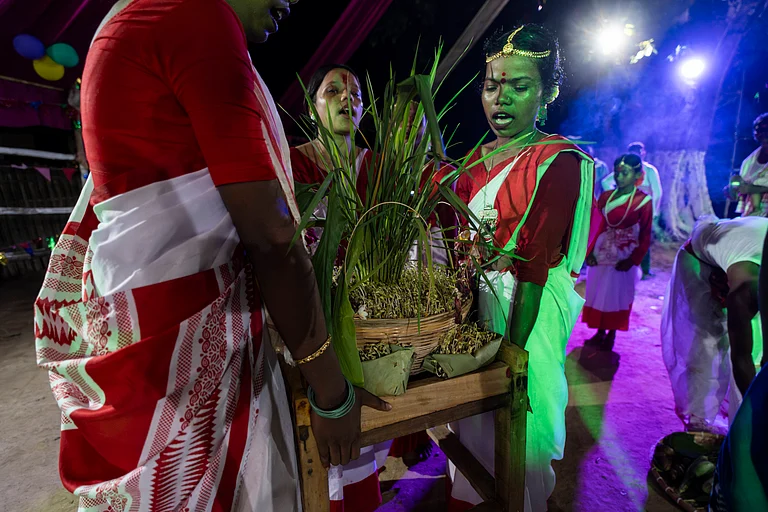Away from anodyne malls, blingy buffets and Michelin star eateries, Old Dubai offers immersive and intimate dining experiences that beautifully showcase the authentic Emirati gastronomic culture.
With over 200 nationalities calling Dubai home, an expansive range of ethnic foods is dished out by the immigrants. In the cobbled streets of Deira, thriving culinary traditions from across the Middle East, North Africa, India and other parts of Asia reinforce the city’s syncretic culture.
Palestinian shops tantalise taste buds with the gooey semolina and cheese pie called kunafa drizzled with sugar syrup and stuffed into a purse-shaped, sesame-studded bun called ka’ak. At an Egyptian eatery I sample kushari (rice dish) and mint-infused falafals so light and airy they seem to float in air. At an Ethiopian hole-in-the-wall eatery, the spongy injera bread dunked into delicious curry transported my taste buds to a place they'd never been. However, the best part about a Deira food trail is that you can also take a peek into the eateries’ kitchens where cooks rustle up yummies the traditional way.

Like Deira, the atmospheric Al Fahidi heritage district too offers delicious treats unblemished by modernity. A glimpse of the city’s life from the mid-19th century comes as a bonus. Formerly known as Bastakiya, Al Fahidi’s historic creek-side buildings, glutinous creek peppered with abras (wooden dhows) with the muezzin’s call resonating in the air ever so often offer a soulful travel experience.
Creative art spaces, museums and restaurants housed in traditional homes crafted from gypsum, coral and limestone add to the visual splendour. Charming local cafes offer hot cups of Arabic coffee known as “Gahuwa Arabia '', a blend of lightly roasted Arabic beans, cardamom and saffron ground and boiled, strained and served hot in small cups with no handles (fenjan). Paired with juicy Mejdool dates, they offer a taste of heaven.
Arabian Tea House, a blue-and-white eatery, dotted with a leafy courtyard, turquoise benches, white rattan chairs and lace curtains, is the perfect pitstop to dig into an Emirati smorgasbord. The restaurant once belonged to a tawash, or pearl merchant and also offers 150 types of tea and drinks.
Its expansive menu proffers gooey knafeh (cheese dessert), pillowy soft pita, muskahan (Lebanese pie); lamb thareed (a traditional Bedouin stew made with marrow, pumpkin, potatoes and tomatoes). There’s also manakish (tiny flatbreads anointed with zaatar, thyme, cheese), grilled haloumi, foul medammas (fava beans), fresh mixed greens, and Arabic breads served with labneh and hummus.

I opt for fouga, a pilaf redolent of fragrant spices and basmati rice mined with meat falling-off-the-bone. Desserts like louqmat (sweet deep fried dough balls) and balaleet, a sweet vermicelli flecked with cinnamon, cardamom and nuts, conclude the decadent meal. The sugar rush leaves me drugged with happiness, but thankfully the piping hot Sulaimani chai revs up my comatose body back into action.
Post meal I saunter around the Creek among its shaded alleyways and between the coral and gypsum wind-tower buildings. I next hop onto an abra for a cruise across the creek to complete my Emirati cultural immersion.
The next day, at the Dubai Miracle Garden, I tried more local food. This is the world's largest natural flower garden where a breathtaking sight of over 150 million flowers in full bloom create a Bollywoodian landscape. The 72,000-sq-m paradise has bloomed into one of the region’s most picturesque, fragrant destinations attracting fans and film crews alike.
The floral wonder is peppered with famous buildings and structures transformed into multi-hued flower exhibits. I amble down its heart-shaped pathways and wander amid petal-powered castles, illuminated landscapes and full-size houses. The two-hour long activity whets my appetite.
The garden has its own food outlets that offer a variety of dining options. At one kiosk, I order dolma, grape leaves bursting with a mixture of rice, vegetables, pine nuts and raisins, flavoured with mint and spices. I also try mutabbal, a smoky eggplant dip, blended with tahini, garlic, and lemon juice and garnished with pomegranate seeds.
On the final day of my visit I hear a buzz of a possible Shah Rukh Khan visit to one of his favourite restaurants in the city -- the Michelin Guide-endorsed Ce la Vie restaurant. I scramble to get a table and can’t believe my luck when I actually do ensnare one. Located on the 54th floor of Sky View Hotel on Sheikh Mohammed bin Rashid Boulevard, the buzzy eatery, always packed with high profile punters, overlooks a breathtaking panoramic expanse of the city. The food – no less inspired -- is premised on the region’s creative legacy and deeply rooted in local artistic influences.
I start with a burrata salad that looks like a painting on a plate. The medley of leafy greens, sun dried tomatoes, slivers of fruit, pine nuts and sweet burrata create a party in my mouth. Up next is a gossamer gold salmon steak served on a bed of tomato broth and crowned with a thin and crisp sourdough toast. The decadent dessert -- mango tiramisu – is so tasty, it vanishes from my plate sooner than I could utter Mohammed bin Rashid Al Maktoum. And though the meal is more bohemian than Bedouin, and I don’t get to see Shah Rukh Khan either, it still offers me a taste of quintessential Dubai, a city that feeds its guests really well.
Neeta Lal is a Delhi-based editor and journalist
























